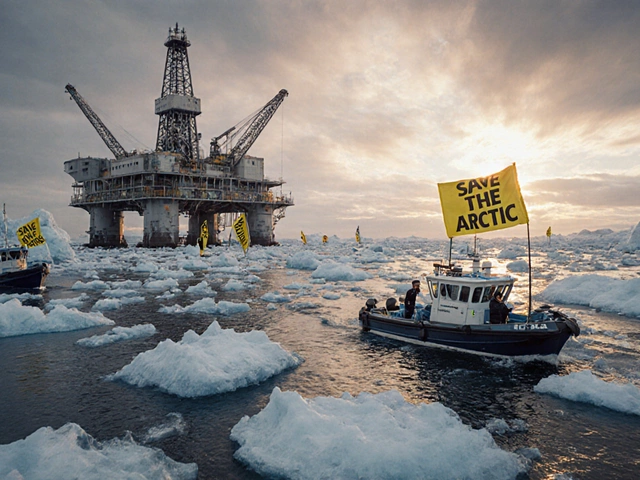Amidst the growing concerns of climate change and biodiversity loss, certain organizations have dedicated themselves to safeguarding our planet. These groups harness human resources, technology, and innovative strategies to mitigate the environmental challenges we face.
Their roles vary from critical conservation projects to advocacy for sustainable practices in everyday life. The question is, who are these organizations, and what unique contributions are they making?
Discover the leaders in environmental protection, explore their groundbreaking initiatives, and find out how you can join the movement for a greener future. Let’s delve into the world of those who tirelessly work to keep our environment thriving, each step creating meaningful progress for generations to come.
- Prominent Environmental Organizations
- Innovative Initiatives and Solutions
- The Impact of Grassroots Movements
- How You Can Help
Prominent Environmental Organizations
In the fight to preserve our planet's well-being, numerous environmental groups have emerged with an unwavering commitment. Among the most reputed is Greenpeace. Founded in 1971, Greenpeace has consistently been at the forefront of environmental activism. Their non-violent approach and bold strategies aim to expose global environmental problems while advocating for solutions that promote peace. They focus on critical issues like climate change, deforestation, overfishing, and pollution, all with the hope of influencing public policy and raising awareness at the grassroots level.
Another significant player is the World Wildlife Fund (WWF), founded in 1961. The WWF is renowned for its dedication to wildlife conservation and reducing human impact on the environment. They operate in over 100 countries, and their primary concern is to protect endangered species and their habitats. The WWF excels at creating transnational partnerships with governmental bodies and other organizations to bolster its conservation efforts. This collaborative approach has helped save countless species from extinction and has preserved extensive habitats around the world.
The Sierra Club, established in 1892, is one of America's oldest and most influential grassroots green organizations. The club originally focused on nature outings and advocacy for nature conservation, but it has since expanded its mandate to include battling climate change, promoting clean energy solutions, and protecting public lands. Their vast network of volunteers and supporters has made them a powerful force in the national and state legislative arenas. Notably, the Sierra Club played a crucial role in the fight to protect the Arctic National Wildlife Refuge from oil drilling.
"The Earth is what we all have in common." — Wendell Berry
A newer but notably effective organization is 350.org, which is focused explicitly on the human impact on climate change. The organization's name references the safe concentration of carbon dioxide in the atmosphere, 350 parts per million, a number scientists believe will stabilize global temperatures. Through engaging campaigns and mobilizing people across the globe, 350.org pushes for divestment from fossil fuels and a transition towards sustainable energy. Their strategy involves empowering local communities to insist on a clean energy future.
Amnesty International has also contributed to environmental causes by underscoring the intersectionality of human rights and environmental degradation. They spotlight how environmental harm disproportionately affects marginalized communities and advocate for their rights in the global dialogue on environmental policy. These efforts have not only highlighted issues previously overlooked but have also brought new allies into the environmental movement.
There is a vast ecosystem of organizations dedicated to environmental preservation, each with its unique mission and methods. Despite coming from different angles, their goals are interconnected, creating a stronger network of support and influence. By understanding and supporting these groups, we can accelerate the pace of positive change and invite collective action for the planet we all share.

Innovative Initiatives and Solutions
Whether it’s combating deforestation or tackling ocean pollution, innovative efforts spearheaded by many environmental groups are showing results in more imaginative ways than ever before. One such example is The Nature Conservancy's use of drones to reseed forests. This initiative focuses on areas ravaged by wildfires and aims at accelerating the regrowth process. By deploying seeds from above, drones can access remote and treacherous landscapes which are difficult for humans to traverse. The result is a significant reduction in time and labor costs while boosting the reforestation rates, something unheard of just a few years back.
Another remarkable initiative comes from 'Plastic Bank', a social enterprise transforming waste into opportunity. By incentivizing the collection of ocean plastic, they not only clean our seas but also empower local communities economically. Collectors can exchange plastic for currency, thus creating a circular economy that benefits both people and planet. Such ingenious projects straddle the line between conservation and economic growth, bridging gaps that once seemed irreconcilable.
In the field of sustainable agriculture, the Rodale Institute has rolled out a pioneering research on regenerative

The Impact of Grassroots Movements
Amid the sweeping initiatives led by prominent environmental organizations, grassroots movements have emerged as a powerhouse for sustainable change. These community-driven efforts connect local wisdom with passionate advocacy to push forward tangible environmental advancements. Often, grassroots movements are born out of a necessity to address environmental issues that large institutions tend to overlook. They offer the dual-benefit of drawing attention to unique local challenges while also promoting larger, systemic changes. Whether it's a group of volunteers combating pollution in a regional river or a local coalition planting urban gardens to boost biodiversity, these initiatives are beacons of hope.
"Never doubt that a small group of thoughtful, committed citizens can change the world; indeed, it's the only thing that ever has." – Margaret Mead
The essence of grassroots movements lies in their ability to mobilize communities with limited resources efficiently. By leveraging local networks, these groups foster a culture of trust, collective responsibility, and shared expertise. This approach not only amplifies their impact but also inspires others to follow suit. A striking example of grassroots environmental activism is the rise of community-led recycling programs in urban neighborhoods. Focusing on reducing waste at the source, these initiatives have significantly contributed to waste management and awareness. They are empowering residents to participate in simple, yet effective sustainability practices that directly benefit their immediate surroundings.
The Power of Local Knowledge and Action
Research indicates that communities engaging in grassroots actions witness an increase in environmental awareness and personal accountability. A study by the Environmental Action Committee found that neighborhoods involved in such movements had their waste reduction metrics improve by an average of 25% over two years. This statistic highlights not only the efficacy of grassroots efforts but also their capacity to instill enduring change. The grassroots movements' strength is their inclusiveness, welcoming individuals to partake regardless of background or expertise. Through workshops, gatherings, and social media campaigns, they educate and engage people on critical topics such as climate change, water conservation, and sustainable living practices.
Yet, the impact of these movements isn't confined to their localities. They often catch the attention of larger media outlets, generating a ripple effect that influences policy change on a broader scale. The Stop Adani campaign in Australia, propelled by grassroots action, is a prime example. It successfully gathered global support, shining a spotlight on the environmental and cultural threats posed by the proposed coal mine. Such movements exemplify how grassroots endeavors can transition from local to global arenas, effectively blending micro and macro-level strategies to champion environmental protection.
Critical to the sustained impact of grassroots movements is collaboration. Partnering with established environmental groups and leveraging technology, these movements are capable of rapid mobilization that garners far-reaching support. Platforms like social media allow for information sharing and event organization that transcend geographic boundaries. This synergy between technology and local efforts has allowed movements to efficiently navigate the contemporary challenges of environmental advocacy. The symphony of grassroots efforts across the globe continues to be a potent force, driving forward an era where each individual's contribution merges into collective progress for a healthier planet.

How You Can Help
Becoming part of the solution for a healthier planet is more accessible than many might think. Everyone has a role to play in supporting environmental groups that are tirelessly working to combat the ever-growing threats to our natural world. One of the most straightforward ways individuals can contribute is through donations. Financial support assists organizations in funding their activities, research, and conservation efforts. Many green organizations offer options where individuals can either make one-time donations or opt for recurring contributions, tailoring their support to fit personal budgets while making a significant impact over time.
Aside from monetary contributions, volunteering your time and skills can be invaluable. Whether it's participating in local cleanup drives or lending expertise for online campaigns and initiatives, the opportunities are diverse and often local. Engaging directly with the environmental groups in your community deepens your connection with the cause and provides a clearer understanding of the efforts necessary to sustain our planet. To find credible volunteering opportunities, platforms like VolunteerMatch and Idealist can be resourceful, connecting passionate individuals to causes aligned with their values.
Educating yourself and others about environmental issues and solutions is another powerful tool. Knowledge breeds awareness, and awareness leads to change. Participating in workshops, webinars, and community meetings hosted by these organizations could significantly broaden your understanding. Consider initiating conversations within your social circles about sustainable practices and the importance of supporting sustainability efforts. As Sir David Attenborough once highlighted,
"No one will protect what they don’t care about; and no one will care about what they have never experienced."
In addition to active participation, adopting more sustainable lifestyle choices can foster a ripple effect of positive change. Start small with conscious decisions like reducing waste, conserving water, supporting eco-friendly products, and minimizing energy consumption. Each personal effort may seem tiny, but together they contribute to a larger impact, propelling forward the vision that these environmental groups champion. An interesting statistic from 2023 suggested that if every household reduced their water usage by just 10%, it could save enough water annually to provide for millions of people globally. Small changes make big waves in our collective journey toward sustainability.





